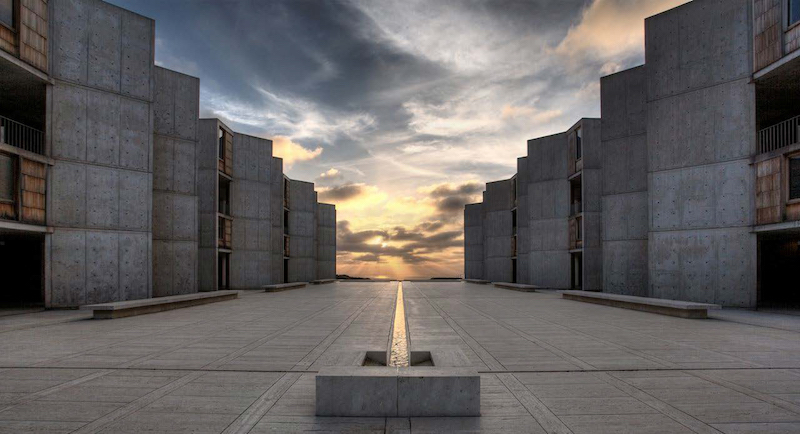After three years of research, the Getty Conservation Institute (GCI) announced construction work is underway to conserve key architectural elements of the Salk Institute for Biological Studies in La Jolla, California. Designed by famed architect Louis Kahn and completed in 1965, the site is widely considered to be a masterpiece of modern architecture.
Dr. Jonas Salk, the developer of the polio vaccine, commissioned Kahn to design the campus for his new scientific research institute on a coastal bluff in La Jolla, just north of San Diego. Kahn worked closely with Salk on the design of the building, which houses laboratories and other research facilities.
But fifty years of exposure in a marine environment has caused the institute’s distinct teak window walls, set within the monolithic concrete walls of the site’s study towers and offices, to weather and deteriorate in a non-uniform manner. The construction work, designed by Wiss, Janney, Elstner Associates, Inc. will address these issues. Getty-led research and funding launched in 2013 as part of the GCI’s Conserving Modern Architecture Initiative (CMAI) helped to initiate the current construction work.
The 203 teak window walls are significant elements of the overall site, expressing a human element and scale within the monumental structure. Although prefabricated, each window has a handcrafted quality due to the detailing of the teak wood by carpenters and customization to fit many sized openings. Each offers a different combination of sliding windows, louvers, and shutters, allowing staff to control light and air in their workspaces.
Research found that the window walls suffered from surface erosion, the growth of a fungal biofilm (likely spread by nearby eucalyptus trees) that gave the wood a black appearance that varied significantly by exposure, changes to teak color due to previously applied sealers and finishes, insect infestation, and moisture infiltration due to the omission of flashings and weather stripping and the failure of sealants.
The GCI and its consultants engaged in historical research, including visits to the Khan archives and collecting oral histories, in order to better understand the significance of the window walls and Kahn’s original vision for the site. It explored the extent of damage to the window walls and performed physical and laboratory analysis to identify materials used and various causes of damage and deterioration. The GCI also convened a meeting of Salk representatives, other Kahn building owners with similar wood conservation issues, and preservation professionals. Possible treatments for the wood and wood replacement options were also researched, as well as design modifications to improve the overall performance of the assemblies. Finally, the GCI, along with the architectural and engineering firm Wiss, Janney, Elstner Associates, Inc. (WJE), which served as the historic preservation consultant to the Salk Institute, developed a series of on-site trial mock-ups to evaluate different repair approaches and treatments to identify the most appropriate ways to move forward.
WJE has developed comprehensive construction documents to implement the repair and conservation of the window walls, with interventions ranging from minor (cleaning and repair), to moderate (cleaning, repair, and some replacement of materials), to major (removal of the entire window assembly where severely deteriorated and replacement using like-for-like materials). At this time, WJE is currently implementing the repair work, which is expected to be completed in 2017.
Related Stories
Reconstruction & Renovation | Feb 16, 2017
Stalled Conference House Park pavilion renovation moving forward
The pavilion has been awaiting repair since storm damage in 2011 rendered the structure unsafe for the public.
Hotel Facilities | Feb 15, 2017
Morphosis redesigns Swiss hotel rooms as custom ‘aesthetic experiences’
The redesigned rooms focused on scale, color, tactility, unexpected form, and connections to the natural context.
Reconstruction & Renovation | Feb 2, 2017
$500 million investment will modernize Chicago’s Willis Tower *Updated*
The project will be the first major renovation in the building’s 43-year history.
Cultural Facilities | Jan 30, 2017
Former windmill factory proposed as new ‘vibrant culture house’
The transformed building would provide space for street sports, street culture, and street art.
Hotel Facilities | Jan 25, 2017
New Denver hotel will integrate historic 130-year-old fire station into its design
The 1883 Denver Hose Company No.1 building will be fully restored as part of the project.
Museums | Nov 18, 2016
Plans for the expansion and renovation of the Asian Art Museum in Seattle unveiled
LMN Architects is the architect and interior designer for the Bebb and Gould-designed museum.
Reconstruction Awards | Nov 11, 2016
Adaptive reuse juices up an abandoned power plant
The power plant was on the National Register of Historic Places and is a Recorded Texas Historic Landmark.
Reconstruction Awards | Nov 11, 2016
Exclusive Chicago club re-emerges as a boutique hotel
Built in 1893 for the World’s Columbian Exposition, the CAA was an exclusive social club founded by leading figures in American sports and commerce.
Sponsored | Reconstruction & Renovation | Sep 13, 2016
Daytona International Speedway becomes racing’s first modern stadium
Daytona International Speedway has undergone a $400 million full-scale makeover to update the facilities first built in 1959.
Mixed-Use | Sep 8, 2016
Former sports stadium to become landscaped gardens, housing, and shops
According to the architects, Maison Edouard François, the project will act as a new green lung for the densely populated neighborhood.
















